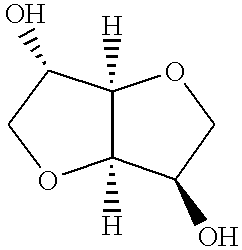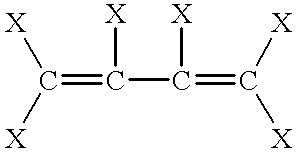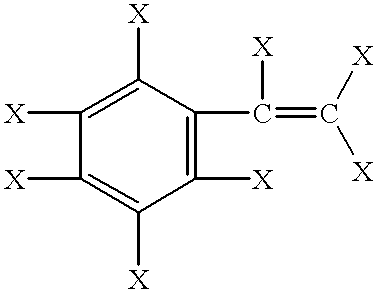Polyesters including isosorbide as a comonomer blended with other thermoplastic polymers
a technology of thermoplastic polymers and polymers, which is applied in the field of polymer blends, can solve the problems of poor reactivity of secondary alcohols such as isosorbide, and the inability to blend high molecular weight polyesters containing isosorbide moiety with other thermoplastic polymers, and achieves the effect of sufficient inherent viscosity, inherent viscosity and sufficient viscosity
- Summary
- Abstract
- Description
- Claims
- Application Information
AI Technical Summary
Benefits of technology
Problems solved by technology
Method used
Image
Examples
example 1
The following polymerization reactants are added to a 50 gal. maximum capacity, Hastalloy B polymerization reactor fitted with a 6" radius, Hastalloy B, water cooled reflux column packed with stainless steel rings, a stainless steel helix agitator stirrer, a water-cooled condenser and by-pass: dimethyl terephthalate (78.02 kg), isosorbide (15.42 kg), and ethylene glycol (49.90 kg), which corresponds to a mole ratio of 1: 0.26: 2.00. The catalyst is also charged and consists of Mn(II) acetate tetrahydrate (29.57 g), Co(II) acetate tetrahydrate (21.43 g), and Sb(III) oxide (35.02 g). This corresponds to 85 ppm manganese (weight of metal as a fraction of the weight of dimethyl terephthalate), 90 ppm cobalt, and 375 ppm antimony. The stirred reactor (50 rpm) is purged with a stream of nitrogen while the temperature is raised to 250.degree. C. over a period of four hours. The reactor is jacketted and uses a temperature controlled, hot oil loop system as a heating medium. Methanol is cont...
example 2
The second example is prepared in a way similar to the first except that a smaller reactor (5 gal. maximum capacity) is used. The reagent equivalent ratios are also changed in order to prepare a polymer with a greater content of isosorbide. Thus, dimethyl terephthalate (10,680 g), isosorbide (5,787 g), and ethylene glycol (4,881 g), which corresponds to a mole ratio of 1:0.72:1.43 are charged to the reactor in a similar fashion as before along with the catalyst consisting of Mn(II) acetate tetrahydrate (4.76 g), and Ge(IV) oxide (4.66 g). This corresponds to 100 ppm manganese (weight of metal as a fraction of the weight of dimethyl terephthalate) and 300 ppm germanium. The germanium oxide is added in the form of a solution in ethylene glycol (0.100 N GeO.sub.2 in ethylene glycol). A solution of polyphosphoric acid in ethylene glycol is added in a similar way as before, in this case 9.6ml, which has a concentration of 3.45 g P per 100 ml of polyphosphoric acid solution, is used. The ...
example 3
The third example is prepared in a way similar to the first except that a larger reactor (100 gal) equipped with a stainless steel anchor type stirrer is used. The monomers charged are such that an isosorbide content in the finished polymer would be 1 mole %, assuming that some of the input isosorbide would be distilled off during polymerization. As such, dimethyl terephthalate (197 kg),isosorbide (5.12 kg), and ethylene glycol (135 kg) along with the catalysts: Mn(II) acetate tetrahydrate (72.1 g), Co(II) acetate tetrahydrate (54.1 g) and Sb(III) oxide (88.5 g) are used. This corresponds to 82 ppm manganese, 65 ppm Co, and 375 ppm Sb calculated using the same basis as in example 1. The transesterification process is carried in an analogous way as for example 1. A polyphosphoric acid solution in ethylene glycol is added such that 80 ppm of P is used to sequester the transition metals after the transesterification step and before the polycondensation as outlined in Example 1. The pol...
PUM
| Property | Measurement | Unit |
|---|---|---|
| temperature | aaaaa | aaaaa |
| mole % | aaaaa | aaaaa |
| glass transition temperature Tg | aaaaa | aaaaa |
Abstract
Description
Claims
Application Information
 Login to View More
Login to View More - R&D
- Intellectual Property
- Life Sciences
- Materials
- Tech Scout
- Unparalleled Data Quality
- Higher Quality Content
- 60% Fewer Hallucinations
Browse by: Latest US Patents, China's latest patents, Technical Efficacy Thesaurus, Application Domain, Technology Topic, Popular Technical Reports.
© 2025 PatSnap. All rights reserved.Legal|Privacy policy|Modern Slavery Act Transparency Statement|Sitemap|About US| Contact US: help@patsnap.com



